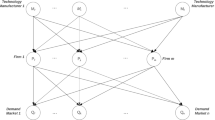Abstract
With the rapid development of information technology, Internet of things is rapidly penetrated into the manufacturing industry, some manufacturers began to adopt the Internet of things technology to produce intelligent products. Focusing on the pricing of products in the home market under the Internet of things technology environment, the network effect and technological innovation are introduced in the condition that consumers’ preferences are evenly distributed and a pricing game model which can reflect the relationship among manufacturers are constructed. On this basis, the optimal subsidy rate of government is designed based on the principle of social welfare maximization. The results show that, with the advantage of low price of ordinary products, the manufacturer 1 (the ordinary household product manufacturer) can also obtain the corresponding market share. The network effect and the degree of product innovation are the important influencing factors for the manufacturer 2 (the intelligent household product manufacturer) to gain the competitive advantage. Increasing the subsidy rate can effectively stimulate the manufacturer 2 to carry out technological innovation, but it will lead to the decline of the total social welfare level.


Similar content being viewed by others
References
Zhao, D.Z., Pan, X.Y., Wu, C.X.: Issues and implications of supply chain management based on internet of things. Mod. Manag. 36(1), 118–120 (2016)
Pigou, A.C.: The Economics of Walfare, pp. 25–40. Macmillian, London (1952)
Hurkens, S., López, Á.L.: Mobile termination, network externalities and consumer expectations. Econ. J. 124(579), 1005–1039 (2014)
Li, X.Z., Wang, Y.: Study on the synergic development mechanism and evaluation of synergic degree of the internet of things industry in china. Soft Sci. 01, 42–46 (2015)
Ding, M., Ross Jr., W.T., Rao, V.R.: Price as an indicator of quality: implications for utility and demand functions. J. Retail. 86(1), 69–84 (2010)
Xiao, Y.B., Wu, P., Wang, Y.L.: Pricing strategies for fresh products with multiple quality levels based on customer choice behavior. Chin. J. Manag. Sci. 18(1), 58–63 (2010)
Mussa, M., Rosen, S.: Monopoly and product quality. Journal of Economic theory 18(2), 301–317 (1978)
Gu, Y., Wenzel, T.: Transparency, price-dependent demand and product variety. Econ. Lett. 110(3), 216–219 (2011)
Zhao, D.Z., Yuan, B.Y., Xu, C.Q.: Product line pricing based on the unknown consumer low-carbon preference. Syst. Eng. 32(1), 77–81 (2014)
Jiang, J.: Do public policies support firm’s innovation—a comparative analysis on the subsidies and tax credit. Sci. Res. Manag. 32(4), 1–8 (2011)
Levén, P., Holmström, J., Mathiassen, L.: Managing research and innovation networks: evidence from a government sponsored cross-industry program. Res. Policy 43(1), 156–168 (2014)
Arias, A.D., van Beers, C.: Energy subsidies, structure of electricity prices and technological change of energy use. Energy Econ. 40, 495–502 (2013)
Chen, G.: From mercantile strategy to domestic demand stimulation: changes in China’s solar PV subsidies. Asia Pac. Bus. Rev. 21(1), 96–112 (2015)
Hoernig, S.: Strategic delegation under price competition and network effects. Econ. Lett. 117(2), 487–489 (2012)
Asioli, D., Næs, T., Granli, B.S., et al.: Consumer preferences for iced coffee determined by conjoint analysis: an exploratory study with Norwegian consumers. Int. J. Food Sci. Technol. 49(6), 1565–1571 (2014)
Kobayashi, S.: On a dynamic model of cooperative and noncooperative R and D in oligopoly with spillovers. Dyn. Games Appl. 5(4), 599–619 (2015)
Hotelling: Stability in competition. J. Econ. 39(1), 41–57 (1929)
Mazalov, V., Sakaguchi, M.: Location game on the plane. Int. Game Theory Rev. 5(01), 13–25 (2003)
Sun, C.H.: Spatial Cournot competition in a linear city with directional delivery constraints. Jpn. Econ. Rev. 65(3), 344–374 (2014)
Acknowledgements
This work was financially supported by Humanities and Social Science Project of Hebei education department (No. ZD201721).
Author information
Authors and Affiliations
Corresponding author
Rights and permissions
About this article
Cite this article
Pan, Xy., Ma, Jz. & Wu, Cx. Product pricing considering the consumer preference based on Internet of Things. Cluster Comput 22 (Suppl 6), 15379–15385 (2019). https://doi.org/10.1007/s10586-018-2601-5
Received:
Revised:
Accepted:
Published:
Issue Date:
DOI: https://doi.org/10.1007/s10586-018-2601-5




